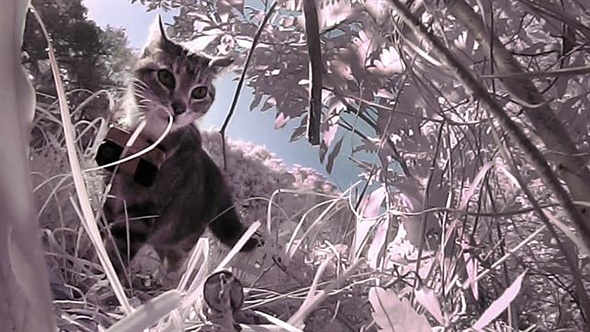
The headline from a National Geographic story posted online earlier this week created immediate buzz: “Island’s Feral Cats Kill Surprisingly Few Birds, Video Shows.” Whether or not you were actually surprised, I suppose, depends largely on how much you’ve been paying attention to the issue.
The team of researchers whose work is described in the NatGeo piece, led by the University of Georgia’s Sonia Hernandez, could—more than most—have anticipated such results. Kerrie Anne Loyd—for whom Hernandez served as PhD advisor—pioneered “KittyCam” research during her doctoral studies at UGA. And in April 2012, Loyd, discussing the results of “KittyCam 1.0” with Atlanta’s CBS affiliate, conceded, “Cats aren’t as bad as biologists thought.”
Perhaps we’re expected to be surprised again?
Many of us are not, of course. And we won’t be terribly surprised to see how the results of the research (yet to be published) are misrepresented by TNR-deniers such as the American Bird Conservancy. But in this case, ABC faces a particular challenge: the organization helped fund KittyCams 2.0.
If history is any judge, though, ABC will rise (or stoop, to be more accurate) to the challenge.
After all, in 2012 ABC issued a joint press release with The Wildlife Society, declaring, “‘KittyCam’ Reveals High Levels of Wildlife Being Killed by Outdoor Cats.” In it was a quote from Loyd completely contradicting what she’d said publicly four months earlier: “The results were certainly surprising, if not startling.”
Among the surprises: “that cats only brought 23 percent of their kills back to a residence.” [1] Sure enough, only nine of the various 39 prey items documented were returned. [2] But which ones?
Here, Loyd (and co-author Hernandez) have surprisingly little to say. In their 2013 paper, “Quantifying free-roaming domestic cat predation using animal-borne video cameras,” the following summary is provided:
Reptiles: 14
Mammals: 10
Invertebrates: 8
Birds: 5
Amphibians: 2
Total: 39
And this additional clue: “our study found that 14 of 16 reptiles and amphibians (88 percent) were either eaten or left at the capture site.” [2]
So, although it’s clear that the vast majority of reptiles and amphibians weren’t returned, we know next to nothing about the return rate for mammals or birds. Which, considering the paper’s title, is more than a little peculiar. Loyd’s dissertation, from which the 2013 paper is derived, provides nothing more, [3] and Loyd’s ignored my repeated requests for the “details” she and Hernandez omitted.
Could it be the lack of transparency was intentional?
Leave readers guessing and they’re liable (again, depending on how familiar they are with the issue) to fill in the blanks for themselves—which is exactly what’s happened. [4, 5] Indeed, ABC’s Grant Sizemore cites KittyCams 1.0 in his presentation Cats, Birds, and People: The Consequences of Outdoor Cats and the Need for Effective Management as evidence that “historical and anecdotal underestimate of total wildlife impact.”
“Wildlife” is a very broad category. Are we talking about worms (three of which were among the 39 prey items documented) or the American robins that have a reputation for consuming them (just one of which was included in the prey tally)?
Again, the ambiguity plays to the advantage of anybody who would misrepresent the results—all without the researchers responsible for reporting the original results having to get their hands (overly) dirty.
Safe to say, we can expect more of the same from KittyCams 2.0. Stay tuned.
Literature Cited
1. ABC “KittyCam” Reveals High Levels of Wildlife Being Killed by Outdoor Cats. 2012. http://www.abcbirds.org/newsandreports/releases/120806.html
2. Loyd, K.A.T., et al., Quantifying free-roaming domestic cat predation using animal-borne video cameras. Biological Conservation, 2013. 160(0): p. 183–189. http://www.sciencedirect.com/science/article/pii/S0006320713000189
3. Loyd, K.A.T., Sociopolitical, Ecological and Behavioral Aspects of Free-roaming Cats (KittyCams: A Window Into the World of Free-roaming Cats), in Wildlife Ecology and Management2012, University of Georgia.
4. Hall, C.M., et al., Assessing the effectiveness of the Birdsbesafe® anti-predation collar cover in reducing predation on wildlife by pet cats in Western Australia. Applied Animal Behaviour Science, 2015 http://dx.doi.org/10.1016/j.applanim.2015.01.004
5. McDonald, J.L., et al., Reconciling actual and perceived rates of predation by domestic cats. Ecology and Evolution, 2015: p. n/a-n/a. http://dx.doi.org/10.1002/ece3.1553
